
EFL · National City (Chile)
Chile
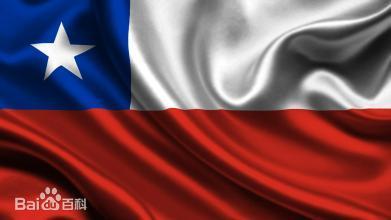
Landmark: University of Chile

Republic of Chile (Republica de Chile)
[Area] 756715 square kilometers.
[Population] 19.678 million, of which 86.9% were urban residents. About 89 percent are white and Indo-European, and about 11 percent are Native American. The official language is Spanish. The Mapuche language is spoken in Indian areas. Sixty-seven percent of the population over the age of 15 are Catholic, and 15 percent are evangelical.
[Capital] Santiago, population 7,314,200. January is the hottest month with an average temperature of 13-30℃. The coldest month is June, with an average temperature of 4-15℃. The average annual maximum temperature is 22.4℃, and the minimum temperature is 8.3℃.
[Head of State] Sebastian Pinera Echenique, inaugurated on March 11, 2018 for a four-year term.
[National Day] September 18th.
Located in the southwest of South America, at the western foot of the Andes Mountains. It is bordered by Bolivia and Argentina in the east, Peru in the north, the Pacific Ocean in the west, and Antarctica in the south. The total length of the coastline is about 10,000 kilometers. It is the narrowest country in the world, 4352 kilometers long from north to south and 96.8 to 362.3 kilometers wide from east to west. Volcanic territory, frequent earthquakes. The climate varies greatly from region to region: the north is the tropical desert climate with no rain all the year round; The middle of the region is a subtropical Mediterranean climate with rainy winter and dry summer. The south is rainy temperate broad-leaved forest and frigid grassland climate.
[Politics] Since taking office, President Pinera has actively promoted political and democratic reform, introduced measures to boost the economy, and implemented a diversified and pragmatic foreign policy. Since October 2019, Chile has been forced to abandon the APEC Economic Leaders' Meeting and the United Nations Climate Change Conference due to riots caused by rising subway fares in Santiago, the capital of Chile. The Chilean government has taken measures to crack down on violence, improve people's livelihood, reshuffle the cabinet and announce a constitutional referendum, which has gradually calmed down the situation in Chile.
The current Constitution came into force on March 11, 1981, and has been amended four times since 1989, 1991, 1993 and 2005. The Constitution says that the president is the head of state and government. The 2005 constitutional amendment changed the presidential term to four years and abolished life senators and appointed senators. Chile voted overwhelmingly in a constitutional referendum in October 2020, and a new constitution is expected to be written within two years.
【 Parliament 】 The National Assembly (Congreso Nacional) has a bicameral system of members and members. Parliament consists of 43 directly elected senators and 155 members of the House of Representatives. Senators serve eight-year terms, half of which are up for re-election every four years; Representatives serve four-year terms.
【 Government 】 This government was formed on March 11, 2018, with a total of 24 ministries and commissions.
[Administrative Districts] The country was divided into 16 Regions, divided into 56 Provincia and 346 Municipalities (Comuna). Regional presidents and mayors are directly elected by voters, while governors are appointed by the president for four-year, renewable terms.
Judicial independence meaning in Chinese The country has a Supreme Court, 17 appeals courts and one military court.
[Political parties] Implementation of a multi-party system, the main political parties are divided into two camps: centre-right and centre-left.
One of the more economically developed countries in Latin America. Mining, forestry, fishery and agriculture are the four pillars of national economy. In 1974, the Pinochet government took office after implementing economic reform, adjusting the industrial structure, fully opening the market, and expanding all-round free trade. Chile has maintained rapid economic growth for many years. Its comprehensive competitiveness, degree of economic liberalization, market openness and international credit rating all rank first in Latin America, and it is regarded as a model for economic development in Latin America. In recent years, the Chilean economy has been affected by the fall in international copper prices, the growth tends to slow. GDP in 2015 was US $240.2 billion, an increase of 2.3%. US $234.9 billion in 2016, up 1.3%; US $263.2 billion in 2017, up 1.5%; US $298.7 billion in 2018, up 4%; From 2014 to 2018, excluding exchange rate factors, the annual growth rate was 2.2%. $291.2 billion in 2019, up 1.1%. Chile's GDP per capita is $15,264, the highest in Latin America. Due to the epidemic, the annual economic growth forecast for 2020 has been revised to around -4%. In recent years, due to the weak international economic recovery and the structural problems of its own economy, Chile's economic development has faced certain challenges. The International Monetary Fund predicts a negative growth of 6% in the intellectual economy in 2020.
Major economic indicators for Chile, 2015-2019

Source: Statistical Office of Chile
Note: Due to the exchange rate between the US dollar and the Chilean peso, the absolute value of some annual GDP converted into US dollars does not directly reflect the growth rate.
Major economic data for 2020 are as follows:
GDP: US $291.2 billion (2019)
GDP per capita: US $15,264 (2019)
Total foreign trade: US $131.9 billion (2019)
Inflation rate: 3.4%
Unemployment rate: 10.7 percent
Foreign reserves: $39.2 billion
External debt balance: US $188.104 billion (as of 2019)
Currency Name: Peso
Exchange rate: US $1 =734 pesos (as of December 2020)
[Resources] Rich in mineral resources, forests and aquatic products. Known as the "Kingdom of Copper", it is rich in copper. The reserves, output and exports of copper rank first in the world, with proven reserves of more than 200 million tons, accounting for about 1/3 of the world's reserves. Iron reserves of about 1.2 billion tons, about 5 billion tons of coal. In addition, there are lithium, saltpeter, molybdenum, gold, silver, aluminum, zinc, iodine, petroleum, natural gas and so on. Rich in temperate forests, excellent wood, Latin America is the largest exporter of forest products. Rich in fishery resources, it is the world's leading producer of farmed salmon and trout.
[Agriculture, Forestry, Animal Husbandry and Fisheries] Agriculture: The output of main agricultural products in recent years is as follows (unit: 10,000 tons) :
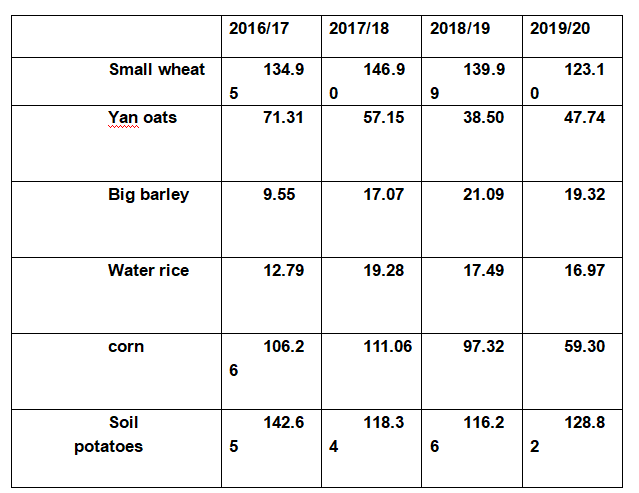
(Source: Chilean National Bureau of Statistics, Chilean Ministry of Agriculture)
The main fruits are apples, grapes, cherries, avocados, blueberries, plums, peaches, pears and so on. The fruit planting area is 344,300 hectares, with an annual output of 4.152 million tons.
[Animal Husbandry] The pasture area is 214,700 square kilometers, accounting for 28.4% of the total land area. The annual output of 2013 was 206,300 tons of beef, 550,000 tons of pork, 680,600 tons of poultry and 3.98 billion liters of milk. Fishery: 4.435 million tons of seafood were caught, including 3.428 million tons of fish, 589,000 tons of shellfish and 418,000 tons of algae.
The total volume of imports and exports accounts for about 60% of the GDP. Implement a uniform low tariff rate (the average tariff rate since 2003 is 6 percent) free trade policy. At present, it has trade relations with more than 170 countries and regions in the world. The trade situation of Chile in recent years is as follows (unit: USD 100 million) :
Export and Import


Export

Import
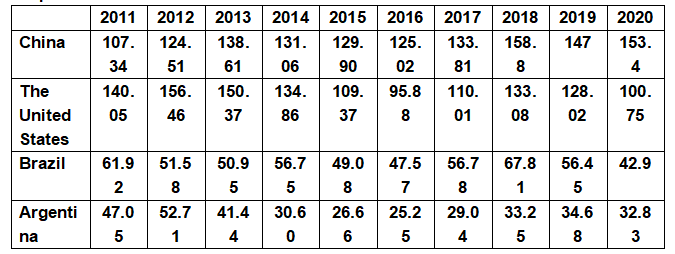
(Source: Chile Customs, China Customs)
[Commodity Structure] The top 10 export categories of Chile in 2019 are: $33.4 billion for copper products, $4.7 billion for salmon, $2.4 billion for pulp, $1.56 billion for cherries, $1.55 billion for bottled wine, $1.2 billion for molybdenum trioxide (semiconductor materials), $1.1 billion for grapes, $1 billion for industrial equipment, $830 million for lithium carbonate, and $810 million for wood. The main imports are petrochemical products, electronic equipment, industrial machinery, automobiles and natural gas.
China-Chile trade has maintained steady development. Since 2012, China has become and remained Chile's largest trading partner, export market and source of import. Chile is China's third largest trading partner in Latin America, after Brazil and Mexico. Chile has a surplus with me. In 2019, bilateral trade reached 39.1 billion US dollars, down 8.7% year on year, accounting for 28% of Chile's total foreign trade. Chile's export to China was US $22.5 billion, down 11% year-on-year, accounting for 31% of Chile's total export. Imports from China fell by 5% to US $16.5 billion, accounting for 23% of Chile's total imports. Chile has a $6.9 billion trade surplus with China. China has been the largest buyer of Chilean copper for many years, and Chilean exports to China also include paper
Pulp, fish meal, fruit, wine, aquatic products, meat, etc. In addition to traditional textile products, China's export to Chile of machinery and equipment and transport vehicles in mining, communications, construction, engineering, energy and other fields has witnessed rapid growth in recent years. In 2019, a total of 59,000 Chinese cars were sold in Chile, surpassing the United States to become the third largest source of auto imports to Chile.
According to Chilean customs statistics, from January to October 2020, Chilean exports totaled 56.27 billion US dollars, down 6.6% compared with the same period in 2019. However, Chile's exports to China bucked the trend and increased by 12.7%, accounting for 36.6% of Chile's total exports in the first 10 months of 2020. Among them, Chile's exports to China reached $2.496 billion in October, up 16.6 percent over the same period in 2019, accounting for 42.4 percent of Chile's total exports in the month.
China-Chile trade situation from 2015 to 2019
(Unit: $100 million)
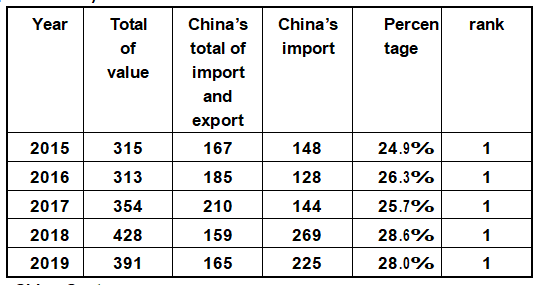
Source: China Customs
According to the statistics of China Customs, the main categories of Chinese exports to Chile in recent years include: 1) electrical machinery, electrical equipment, audio-video equipment and their accessories; ② mechanical appliances and parts; (3) Clothing and clothing accessories that are not knitted or crocheted; (4) knitted or crocheted clothing and clothing accessories; (5) vehicles and their accessories, except railway vehicles; ⑥ Shoes, boots, leg protectors and similar products and their parts; ⑦ Iron and steel products; Today the iron and steel; ⑨ Toys, games or sporting goods and their accessories; Attending the furniture. Bedding, etc. Lamps and lanterns; Mobile home. According to Chinese customs statistics, the main categories of goods imported by China from Chile in recent years include: ① copper and its products; ② ore sand, slag and ash; (3) fibrous cellulose pulp such as wood pulp; Waste paper and paperboard; (4) residues and wastes from the food industry; Formulated fodder; ⑤ inorganic chemicals; A compound such as a noble metal; ⑥ Fish and other aquatic invertebrates; ⑦ Wood and wood products; Charcoal; ⑧ eating fruits and nuts; The peel of fruit such as melon; ⑨ Beverages, wine and vinegar; Attending oilseeds. Places; Industrial or medicinal plants; Feed.
In 2019, Chile's exports to China amounted to $17 billion in mineral products, down 15% year on year, including $16.3 billion in copper products, down 15%. Exports of agricultural, animal husbandry and fishery products reached $2.1 billion, up 37% year on year, among which exports of fresh fruits reached $1.95 billion, up 41%. Exports of industrial and processed goods totaled US $3.5 billion, down 9.3 percent, including US $740 million of non-salmon food products, up 48 percent, and US $270 million of salmon products, down 3.5 percent; Bottled wine $250 million, down 0.8%; Fiber pulp $1.3 billion, down 26 percent; Timber and wooden furniture exports were $320 million, down 2.6 percent; US $260 million in chemical exports, up 22%; Exports of machinery and equipment reached 290 million US dollars, down 1.9% year on year.
In the same year, Chile imported 8 billion US dollars of consumer goods from China, including personal electronic products, clothing, shoes and hats, personal articles, toys and food, etc., a year-on-year decrease of 9.3%. Imports of intermediate goods, including primary products such as cloth and fuel, were $5.6 billion, down 3.9 percent, while imports of capital goods, including automobiles, locomotives and machinery and equipment, were $3.1 billion, up 1.3 percent.
Corporacion Nacional del Cobre de Chile (Codelco), founded on April 1, 1976, is one of the world's largest copper producers. It is engaged in the development, mining, refining, processing and marketing of copper mines.
Sociedad Quimica y Minera de Chile S.A. (SQM) : Founded in 1968, SQM specializes in the production and distribution of fertilizers, chemical products, iodine and lithium.
Molibdenos y Metales S.A. (Molymet), founded in 1975, is the world's leading manufacturer of molybdenum, with a global market share of about 1/3. Molymet is engaged in the production and sales of molybdenum and related products.
Compania Sudamericana de Vapores S.A. (CSAV) : Founded in 1872, CSAV is the largest shipping company in Latin America, engaged in shipping and related supporting services.
Chile's culture
History and culture:
In the early period, the territory was inhabited by the Alaugan people, the Fire people and other Indian nations. It belonged to the Inca Empire until the early 16th century. In 1535, Spanish colonists invaded northern Chile from Peru. After the founding of the city of Santiago in 1541, Chile became a Spanish colony and was ruled by Spain for nearly 300 years. September 18, 1810, Chile formed the ruling council, the implementation of self-government. In February 1817, allied forces with Argentina defeated the Spanish colonial forces. Independence was formally declared on February 12, 1818, and the Republic of Chile was established.
Culture and Art:
It is one of the countries with high cultural and artistic standards in Latin America. There are 1,999 libraries in China, with a total collection of 17.907 million volumes. There are 260 cinemas. Santiago, the capital, is the center of national cultural activity, with 25 art galleries. Poet Gabriela Mistral won the Nobel Prize for Literature in 1945, becoming the first South American writer to win the prize. Poet Pablo Neruda won the 1971 Nobel Prize for Literature.
- Frame plate: hot news
(1) More than 1,000 cactus were illegally traded, intercepted in Italy and sent back to Chile, the country of origin -- China Green Development Association
https://baijiahao.baidu.com/s?id=1699514384765425958&wfr=spider&for=pc
(2) Chile COVID-19 Slight Slowdown of Draft Constitution Member Elections and Governors Elections to Hold -- A CCTV News
https://baijiahao.baidu.com/s?id=1699410432599610665&wfr=spider&for=pc
(3) 3771 new confirmed cases of COVID-19 in Chile, totaling 1,256,546 confirmed cases -- CCTV News
https://baijiahao.baidu.com/s?id=1699497066006989873&wfr=spider&for=pc
- Frame: countries, human geography
Republic of Chile (Spanish: Republica de Chile; English: Republic of Chile, or Chile for short. Located in southwest South America, at the western foot of the Andes Mountains. It is adjacent to Argentina in the east, Peru and Bolivia in the north, the Pacific Ocean in the west, and Antarctica across the sea in the south. It is the longest and narrowest country in the world with a land area of 756715 square kilometers.
Chile was originally inhabited by the Araucans, Mapuche, and Fire Indians, and was part of the Inca Empire before the early 16th century. In 1535, the Spanish began to invade, and in 1541 it became a Spanish colony. On September 18, 1810, a ruling council was formed and self-government was exercised. Since then, the Chilean people under the leadership of Bernardo O 'Higgins began to fight against Spanish colonial rule. In February 1817, allied forces with Argentina defeated the Spanish colonial forces. Independence was declared in 1818. A military junta took power in 1973 and representative democracy was restored in 1990.
Chile is a member of the Community of Latin American and Caribbean States (CELAC) and the Forum for the Progress of South America, and is also known as the ABC country along with Argentina and Brazil. It has a high level of international competitiveness and quality of life, a stable political environment, a globalized and liberal economic environment, and low perceptions of corruption and relatively low poverty rates. Recognized by the World Bank Group as a high-income economy. In 2010, Chile became the first OECD member in South America. Chile is the country with the largest copper reserves in the world, and the country with the largest copper production and export in the world, so it enjoys the reputation of "Copper Kingdom". Chile also scored highly in terms of press freedom, human development index and democracy index. (Source: Baidu Baike)
(1) The only city in Chile without "green" : 400 years without rain, half sea and half fire! - good video at https://haokan.baidu.com/v?vid=8697668891957660573&pd=pcshare
(2) the history of the first, the earthquake to the earth's rotation, the century of natural disasters in 60 years ago [9.5 - bilibili website https://www.bilibili.com/video/BV1GE411L79S?share_source=copy_web
(3) The prices here are too high! How much does it cost to travel to Chile? - good video at https://haokan.baidu.com/v?vid=8205404941903929704&pd=pcshare
(4) How terrible was the 9.5 magnitude earthquake, the strongest in Chile's history? Old man: Chile won't forget in my life - good video at https://haokan.baidu.com/v?vid=10519960601024890728&pd=pcshare
- Frame plate: the latest news (about 10 pieces)
(1) I don't know, there are so many delicious foods in Chile! - netease https://www.163.com/dy/article/G9IIOOJ705520S95.html
(2) Chile works with Chinese authorities to ensure food safety for consumers -- netease News
https://news.163.com/21/0201/14/G1ON8U1O00019OH3.html
(3) the Chilean ambassador to China to visit sichuan cooking "show" : ji deepening cooperation in both food and agriculture - China news website https://www.chinanews.com/cul/2020/12-09/9358374.shtml
(4) the cherries to freedom and to security: Chile is committed to perform a series of security measures recommended by the Chinese - netease to subscribe to https://dy.163.com/article/G1R8485Q0514DTKM.html
(5) A Bite of Chile, Enabling a Healthy Lifestyle
https://finance.ifeng.com/c/7wefO4imYCW
(5) cutting edge news! Chilean 1 batch of frozen king crab packaging detection will be coronavirus, imported frozen food can safely eat? -- tencent https://new.qq.com/omn/20201128/20201128A061ZP00.html
(6) Chile copper blueprint plan for the future development - https://futures.hexun.com/2019-02-20/196194484.html with dispatch futures
(7), Chile agricultural giant love pavilion food off food exhibition in 2020, to further promote the development of imported food safety - netease news at https://news.163.com/20/0928/17/FNKLF28M00019OH3.html
- new interface evening news 】 【 the food safety law implementing regulations come into force as of 1 December Chile is expected to move to Madrid host interface news conference on climate change - https://www.jiemian.com/article/3640935.html
- Professional frame plate
- Frame plate: Country, food introduction
【 Fruit farming 】
Chile is the largest exporter of fresh fruit in the southern hemisphere. The fruit industry already accounts for nearly 30 percent of Chile's total agricultural and livestock production and provided about 800,000 jobs in 2018. Chile's fruit planting area is about 300,000 hectares, with an annual output of 5 million tons of various fruits, more than half of which are exported. Chile has more than 9,000 orchards, mainly apple, grape, nectarine, plums, pears, cherries, blueberries and other varieties. We export 75 kinds of fruits to more than 100 countries and regions around the world. According to the latest data from the Chilean fruit exporters' association, Chile exported 2.3 million tons of fresh fruit during the 2018-2019 harvest season (1 September 2018 BBB 0 22 May 2019), up 9.87% year on year. The United States remains Chile's largest export destination for fresh fruit, with 610,000 tons exported this quarter, up 6.6 percent from a year earlier. For the first time, Latin America became the second largest market for Chilean fruit exports, receiving 585,000 tons of Chilean fruit, up 65.9%. Asia was the third largest export market, importing 583,000 tons of Chilean fresh fruit, up 7.2%, of which China imported 409,000 tons, up 9.8%. China is also the second largest destination for Chile's fruit exports.
For the 2019-2020 harvest season (up to 26 April 2020), fresh fruit exports totaled 1.727 million tons, a decrease of 4.6 percent. In terms of export regions, the Far East is 31.6%, North America 30.4% (US 28.4%, Canada 2%), Europe 20.5%, Latin America 14% and the Middle East 3.4%. In terms of destination country, China's total was 442,766 tonnes, an increase of 11.36% over 2017-2018; It was followed by the United States at 490,690 tonnes and -28.8 per cent respectively
Since the 1970s, Chile's fruit production has developed strongly, with steady growth from 1984 to 2005. In recent years, the planting area has been expanding, and the production efficiency has been gradually improved. In 2019, the fruit planting area has exceeded 340,000 hectares.
Chile mainly grows grapes, apples, kiwi, avocado, nectarine, plums, pears and peaches and other fruits. Its export volume ranks first in South America, table grapes and plums ranks first in the world, avocado export ranks second in the world, kiwi third, nectarine fourth and apple and blueberry fifth.
(2) Chile's ranching area is about 214,700 square kilometers, mainly concentrated in the Central Valley and the southern plains, mainly raising cattle, sheep, pigs, chickens and other livestock and poultry. The main livestock products are: the number of cattle raised is about 3,108,000 (2019), the number of sheep raised is about 2,485,000 (2017) and the number of pigs raised is about 2,608,000 (2018). In 2019, Chile produced 212,000 tons of beef, 53,000 tons of pork, 765,000 tons of poultry, 25,000 tons of lamb (2017), and 2,245 million liters of fresh milk (2019).
[Fishery] Chile is a major producer of farmed salmon and trout in the world due to its superior climate, geography and water quality.
In recent years, the production of seafood in Chile has gradually declined. The main reasons are as follows: First, due to the gradual reduction of fishery resources, the government has issued a fishing ban in order to protect the resources and imposed quotas on fishing; Second, climate factors such as El Nino have a great negative impact on fisheries.
In 2019, Chile exported $6.559 billion of agricultural, forestry and fishery products, according to the Chilean government. Exports of processed salmon were $4.664 billion, and exports of all processed foods were $9.966 billion. Other products include dried seaweed, smoked foods, fish oil, dehydrated products, etc.
Larger enterprises in the fishery field in Chile are mainly aquaculture enterprises, which mainly include Aquachile, Multiexport, Mainstream and Marine Harvest. Other big cultivar exporters include Tral, Salmones Itala and Hornos Marinos Chiloe.
[Wine Industry] Chile's unique geographical conditions and Mediterranean climate provide favorable conditions for the growth of grapes. Since the 1990s, Chile's wine industry has been greatly developed and has become an important new wine producing region in the world. The main Chilean grape varieties include Cabernet Sauvignon
(Cabernet Sauvignon), Carmenere, Merlot and Sauvignon Blanc.
The main traditional export markets of Chilean wine are the United States and the United Kingdom, while exports to Asian countries such as Japan and China show rapid growth. According to the latest data from the Political Research Office of Chile's Ministry of Agriculture (ODEPA), Chile's wine exports in 2019 were $1.929 billion, down 3.5% from 2018 ($1.999 billion). In Chile's overall exports, wine ranks below forest products, fruit and salmon in terms of exports, but it has surpassed white meat. For the fourth year, China has been the top destination country for Chilean bottled wine exports. For the past five years, China has accounted for almost 10 per cent of Chile's total alcohol exports. In 2019, the figure was 17.1 percent, while back in 2013, it was just 6.6 percent.
(3) Curanto is the traditional Chilean way of cooking meat and seafood. Hot stones are placed in a pit, and chicken, pork, sausage, seafood, potato dumplings, potatoes and various vegetables are placed inside, each layer of which is lined with rhubarb leaves to trap the steam inside.
When cooked, meat and seafood are usually served with sauce and hash browns.
- Frame: Food Standards [State Administration for Market Regulation]
Chile and China's relevant departments to work together to ensure consumer food safety netease news at https://news.163.com/21/0201/14/G1ON8U1O00019OH3.html_
Video | fancy promote Chilean agricultural and sideline products, Chilean ambassador to China on-site cooking! https://baijiahao.baidu.com/s?id=1685606040474364218&wfr=spider&for=pc- sichuan news SCOL
- Framework: Policies and regulations [State Administration for Market Regulation]
7.1 What are the regulations and policies on foreign trade?
7.1.1 Trade authorities
The foreign trade department of Chile is the Subrei (International Economic Relations) of the Ministry of Foreign Affairs. Other ministries involved in international trade include the Ministry of Finance, the Ministry of Economy, and the Ministry of Agriculture. In addition, there is an inter-ministerial Committee for International Economic Negotiations (with the participation of the private sector).
Main responsibilities: implement and coordinate the government's international economic policies, negotiate and manage international economic and trade agreements, promote the country's participation in world economic affairs, and promote the export of its goods and services.
7.1.2 Trade legal system
Trade-related legal system in Chile
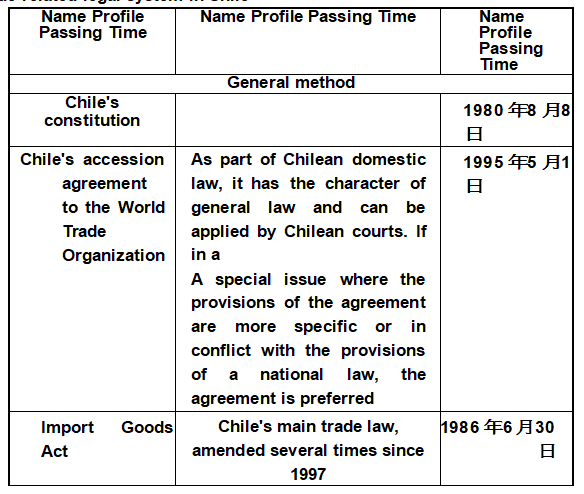

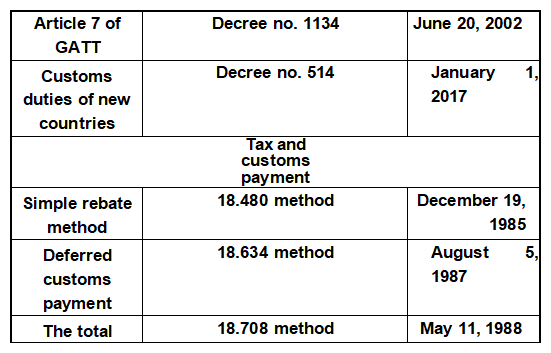
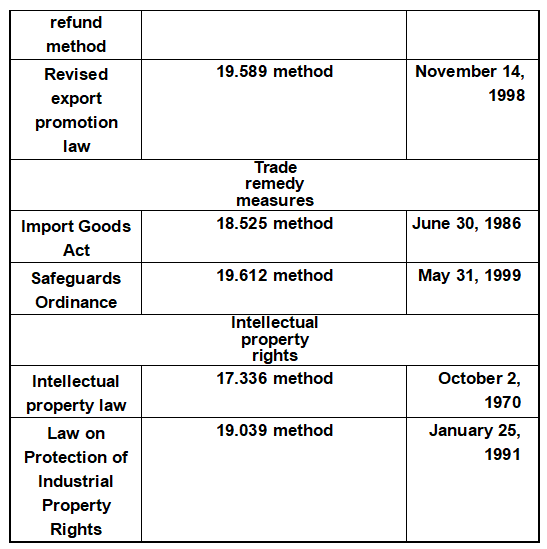
Source: website of relevant departments of the Chilean government
7.1.3 Relevant provisions on trade management
The main objective of Chile's trade policy is to improve the efficiency and competitiveness of domestic producers; Reducing physical protection and removing barriers to exit; Promoting regional economic cooperation; Promote export and attract foreign investment.
Since 1997, Chile has continued to implement a liberalized trade management system. In 2003, it further unilaterally reduced tariffs (implementing a single tariff of 6%), reformed trade remedy measures, and enacted measures to promote exports. Chile is actively involved in the multilateral trading system, participating in the negotiations on agricultural and financial services, basic telecommunications and the Doha Development Round, and ratifying and implementing articles IV and V of the GATT. Chile is a founding member of the Trans-Pacific Partnership Comprehensive Progressive Agreement (CPTPP). In June 2012, Chile, Peru, Colombia and Mexico officially announced the establishment of the "Latin American Pacific Alliance".
Chile has no quantitative restrictions or licensing measures on imported products, but bans the import of used cars, motorcycles, recycled tyres, toxic and hazardous goods, endangered animals and plants, etc.
7.1.4 Inspection and quarantine of import and export commodities
The Ministries of Agriculture, Health and Economy of Chile are responsible for implementing the WTO quarantine measures.
The Agriculture and Animal Husbandry Bureau (SAG) of the Ministry of Agriculture is responsible for animal and plant health related matters, including export product certification, domestic consultation, etc. The Ministry of Health, through the Division of Environmental Projects, is responsible for the implementation of inspection and quarantine regulations relating to human health. The Ministry of Economy is responsible for quarantine of water products through the National Fisheries Administration.
According to the relevant regulations, the import of all animal products, plant products and seed products, regardless of the origin of the products, is subject to inspection and quarantine. All imported animal and plant products must have a health certificate of origin covering the place of origin, the place of export, the good state of health of the animals and plants and the absence of infectious diseases; Plant products must also be issued by the relevant department of the exporting country without carrying pests and diseases certificate; Consumer goods for human consumption must have food inspection certificates.
The Ministry of Agriculture and the Ministry of Health of Chile accept health certification issued by foreign quarantine inspection authorities using international standards such as FAO, the World Organization for Animal Health and the International Plant Protection Agreement.
All aquatic products must be certified as sanitary, and the Chilean Ministry of Fisheries acknowledges the inspection results issued by Denmark, Iceland, Ireland, Scotland and the United States. Products from other countries must undergo local inspection.
Chile's animal and plant inspection and quarantine measures are the responsibility of the relevant technical departments, and all trading partners are treated equally during the implementation process, with no discrimination between domestic and imported products.
Institutional cooperation agreements have been signed between Chile's Ministry of Agriculture and Farming and the following countries: Argentina, Australia, Brazil, Bolivia, Canada, China, Colombia, Costa Rica, Cuba, the Czech Republic, Dominican Republic, Ecuador, France, India, Mexico, New Zealand, Nicaragua, Paraguay, Peru, the Philippines, the United States, Uruguay, Venezuela and Vietnam.
7.1.5 Customs management rules and regulations
[Import] The Chilean Customs Law stipulates that the import of goods must have the declaration documents approved by the customs. The declaration documents should include: information of exporter, carrier, importer, consignee, customs agent, description of goods (weight or quantity, unit price, HS number), tariff number of importer and CIF price, etc. The declaration documents should be submitted to the Chilean Customs together with the original invoice, the customs agent documents, the declaration of value, the animal and plant health or other quarantine certificates, and the certificate of origin. Customs clearance must be submitted electronically and import duties must be paid at designated banks. The import value of goods over 500 US dollars must be entrusted to the customs agent.
Special import procedures apply to free trade processing zones and goods in transit. Foreign goods exported to the free trade zone must have shipping certificates for the free trade processing zone. Goods shipped to the free trade zone can only be used for resale or further processing in the zone before being shipped to the customs or another free trade zone. International transit declaration documents must be provided before the goods are shipped.
Chile levies a flat tariff of 6% on imports. Due to free trade agreements with major trading partners, Chile's effective import tariff rate is less than 1 per cent.
Chile does not impose any tariffs on exports. The Customs Law stipulates that when exporting products, exporters should fill in a single export form, indicating the exporter's address, contact information and product description (customs classification number, unit price, quantity or weight). In addition, the customs broker information, transport documents, copies of invoices and quality certification must be submitted.
In the first quarter of this year the Chilean salmon and trout exports from down to up http://news.foodmate.net/2021/05/592478.html - food partner network
- Frame plate: exhibition and exhibition (food)
Chile Food and Services Exhibition
Venue: Espacio Riesco Exhibition Center, Santiago, Chile
Organized by: Espacio Food & Service
Exhibitors: all kinds of food, food industry equipment and materials suppliers, food production and service enterprises, etc
http://espaciofoodservice.cl
Contact: Alejandra Bustos
Telephone: 56-2-2470 4400/2470 4422
Email:ferias@espacioriesco.cl
8.2 Chile International Wine and Vintage Technology Exhibition Sitevinitech
The basic information
Name (English) : Sitevinitech, Chile International Wine and Vintage Technology Exhibition, 2021
Name (English) : Sitevinitech
Exhibition Date: May 00, 2021 - May 00, 2021
Venue: Santiago, Chile
Exhibition cycle: once a year
Organiser: Feria Internacional de Santiag-Fisa
Organizer: Beijing Zhongling International Exhibition Co., Ltd
Industry attributes
Food processing and packaging industry
Exhibits range
Grape planting equipment, wine cellar equipment and supplies, oenology, culture and wine products, filling equipment, wine marketing, irrigation equipment, grape seedlings, vines, fruit and vegetable packaging, measuring equipment, software, etc.
The exhibition to introduce
SITEVINITECH is an alliance created by SITEVI and VINITECH, two important exhibitions in the French grape - wine and fruit and vegetable fields. Sitevinitech's first exhibition, held at the Arena MAPP Casino and Resort in Mendoza, provided visitors with a full range of multi-layered innovations and showcased advanced techniques in wine and fruit and vegetable farming. Industry professionals from all over the country consider Sitevinitech Argentina a hit at the International Trade Fair.
The market background
Chilean wine was gradually introduced to the world after the 1990s, because of the advantages of low tax, unique taste, and so on, is popular with the public. Because of the unique climate of Chile, the grapes it produces have their own flavor, which lays a foundation for the production of high-quality wine. Coupling with the ancient winemaking methods in Europe, the wine produced in Chile is not only European tradition, but also South American flavor, giving a sense of overlap between the old and the new, which is the unique feature of Chilean wine.
Learn more exhibition information please visit the exhibition's official website: http://www.sitevinitech.cl/
8.3 Chile International Catering Exhibition
Location: Casapiedra, Santiago, Chile
Organized by: Asociacion Chilena DE Gastronomia
Exhibitors: catering industry equipment and materials suppliers, food production enterprises, beverage and alcohol enterprises, logistics, technology, communications, hotels, restaurants, etc
Learn more about the exhibition:
achiga@eiigachile.com
achiga@achiga.cl
Contact: Jacqueline Rodriquez
Telephone: 56-2-22 036363
Fax: 56-2-22 036332
Email:jrodriquez@achiga.cl
- Frame plate: food category
Chilean seafood is very rich, especially lobster and oysters (May to August). Local meals include: eel soup (Caldillo de Congrio), shellfish (Chupe de Mariscos). Chicken and vegetable soup (Cazuela de Ave), flurries with meat, Onions, eggs, olives and the chef's favorite ingredients (Empanadas), spicy corn zongzi (Hamitas), steak and rice (Bife Lomo), hot dogs (Vienesas) seasoned with tomatoes and Onions, Steak noodles (Talarines con Lomito) in a clay pot.
Bars and clubs are open from 18:00 to 1:00 (the next day). The local white wine is both cheap and good. The main white wines are Santa Carolina and Cousino Macal, while Tarapaca ex Zavala is a Burgundy wine. Locals drink pisco(a wine distilled from grapes); Aguardiente is a brandy - like drink with a high alcohol content; Cola de Mono (Christmas wine) tasted good and was sold in downtown bars. Escudo is a beer enjoyed by the general public.
Chileans entertain guests with rich varieties of meals and unique flavors. The staple food for the guests is a kind of tender corn cake called "choko" made of fresh corn flour, "rice in broth" made of rice, corn flour, meat soup and vegetables, pies made of cheese, seafood and pies made of minced meat, onion, raisins, olives, eggs and so on.
The dishes are made of pork, beef, mutton, Onions, potatoes, tomatoes, raw vegetables, cabbage, string beans, soldier beans, chickpeas, etc., among which the roast is a large component, fragrant, delicious. There are all kinds of fruits on the table for guests, such as apples, oranges, grapes, watermelon, melon, plum, apricot, peach, strawberry, lychee and mountain olives. Chileans call fruit a natural sweet. Chileans love drinking, hospitality is not without wine, low-alcohol white wine, red wine, white wine, etc., is the standby wine for hospitality.
- Frame: brand recommendation
- Concha y Toro: Casillero del Diablo, Don Melchor
Cousino Macul Cousino Macul
- Vina Tamaya
- Viu Manent
- Vina Errazuriz
- Kingston Vineyards
- Casa Silva
- Vina Aquitania
- Vina Santa Cruz
- Vina Von Siebenthal
- Corporate Recommendation
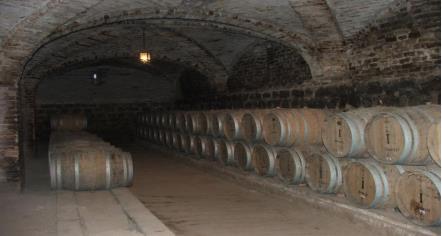
(1) Major Chilean wine producers include: Concha y Toro, Santa Rita, San Pedro, Tarapaca, Errazuriz, Montes, Emiliana, etc.
Chilean Concha Y Toro has 130 years of history, the Guilisasti family bought in 1957. At present, it has 50 vineyards with 10,389 hectares of planted area, the second largest in the world, of which 8,800 hectares are in Chile, the rest in Argentina and the United States. Our wines are sold to more than 135 countries and regions around the world, ranking fifth in sales volume. About the top ten wineries:
- Concha y Toro
Casillero del Diablo is one of the largest winemakers in Latin America and is the world's most famous wine producer. It is also one of the oldest wineries in Chile. Don Melchor Santiago de Concha y Toro founded the winery in 1883. The Chateau's famous Cabernet Sauvignon, Don Melchor, is made in honor of Mr. Dry Dew. About an hour's drive from Santiago, Dry Dew is well worth a visit.
- Cousino Macul
Chateau Cuccino is located in the Maipo Valley, the closest grape region to Santiago, the capital of Chile, which is also the cradle of Chilean wine. Red wine is produced here, mainly Cabernet Sauvignon, Pinot Noir and Carmenere. Many of Europe's existing vines have been transplanted from Chile, where grapes did not suffer from the disastrous phyllophidosis that afflicted Europe in the 19th century.
Chateau Cuccino is also one of Chile's oldest wineries. Founded in 1856, it is the only winery in the region still controlled by the original family after more than a century. Chile's first vines were planted here in 1546. Chateau Cuccino is in the middle of downtown San Diego, but most of its vineyards are elsewhere. The Chateau building dates back to 1872 and is definitely one of Chile's most rewarding wineries to visit.
- Vina Tamaya
Grand Maya winery is located in the Limari Valley in northern Chile, the best coastal region of Chile (Costa). Humboldt, the Peruvian ocean current, brings cold air to the coastal area and also brings fog, which can keep the night low temperature in the early morning and let the vines sleep late. It also brings humidity, which is especially important in the dry north. The high temperature during the day allows the grapes to grow and ripen well, while the large temperature difference between day and night makes the wine delicate and elegant.
The history of Chateau Grande Maya dates back to 1826, when the current owner, Rene Merino Blanco's forefather, Numan El Blanco Encarada, a wine enthusiast who pioneered vine-growing in the Limari Valley, was elected Chile's first president. It opened the prelude to the Chilean wine industry. Grande Maya is a very famous Chilean wine brand. The famous Chilean agricultural expert Francisco once praised Grande Maya as the Ferrari of the winery.
- Viu Manent
Located in the Colchagua Valley grape region in the foothills of the Andes Mountains, Chateau Vimar was founded in 1935 by the Viu Manent family and has been in development for 80 years. Waimar Winery is committed to producing wines that truly reflect the characteristics of the varietal and origin while respecting the environment. There, visitors can ride in a horse-drawn carriage and enjoy their wine and food while taking in the stunning views of the vineyards.
- Vina Errazuriz
Chateau Errazuriz was founded by Don Maximiano Errazuriz in 1870. It is located in Chile's Aconcagua Valley, 100 km north of Santiago. The region has cool, rainy winters and hot, dry summers, producing fine, supple wines. A visit to the Chateau Erasu is an absolutely luxurious experience. A tour of the most modern Don Maximiano building, the historic cellar, and then a taste of some of the special food is a treat.
- Kingston Vineyards
In the early 1920s, Karl John Kingston, a humble miner from Michigan, followed the gold rush to Chile's Casablanca Valley. After a fruitless gold rush, Kingston turned to 7500 acres of local land for ranching. Five generations later, the Kingston family took that entrepreneurial spirit and turned the farm into a winery.
In 2010, the Casablanca Valley was hit by a devastating earthquake that severely affected the region's wine industry. The local wine industry has returned to normal, and while the Casablanca Valley is known for its white wines, Kingston has led the way in producing fine reds. Today, the wines of the chateau have been sold to all corners of the world.
- Casa Silva
Chateau Silva, also known as Chateau Silver, is one of Chile's most gorgeous wineries, located in the Colchagua Valley. The winery consists of an ancient wine cellar, a boutique hotel, a gourmet restaurant and an equestrian club. In addition to several hundred acres of vineyards, the chateau also boasts a large polo field. The Chateau has a number of well-known premium brands, notably its Camignon and Sauvignon Blanc.
- Vina Aquitania
Chateau Baizilian is a boutique winery located in the valley of Maipo in the foothills of the Andes. A subway ride from San Diego offers spectacular views of towering mountains on one side and the city's prosperity on the other. The winery team is small and focuses on producing a limited number of fine wines. There, a winery guide will take you on a tour of their winemaking process and you can witness the birth of a bottle of wine.
- Vina Santa Cruz
Chateau Santa Cruz is definitely one of the top 10 must-see chateaux in Chile, with an indigenous museum, an astronomy center and, most importantly, a cable car ride high above the vineyards for breathtaking views. Or ride a llama to see the vineyards and learn about the winemaking process before taking a cable car up to the top of the mountain to an Aboriginal village built specifically for tourists. There, your guide will explain the culture of pre-Columbian Chile, and you can see a variety of telescopes at the observatory. A wine tour like this is a wonderful one.
- Vina Von Siebenthal
Cerponta is located in Chile's Aconcagua Valley. Mauro Von Siebenthal, a Swiss lawyer, founded the winery in 1998. Ten years later, the Srebanta winery produced six red wines. Located in a semi-desert area between the Andes Mountains and the Pacific coast, the vineyard is blessed with unique terroir conditions. Its wines are elegant and unique.
(2) Main fruit production and export enterprises: Hortifrut Chile S.A., Copefrut S.A., Unifrutti Traders LTDA, Dole Chile S.A., Del Monte Fresh Produce (Chile) S.A.
- Professional data
- Frame: Country, Food Data
2019 fresh https://www.baidu.com/link?url=fJKL_Eo5hdGojfBzE-Nd_a38UuwrPKzEQPZpzhsPlYknMWk9hfHGL-QKQwrYsI70cEwi2X global wine trade data report Z3pCwsAwisy2gWba & wd = & eqid = c69eec2a0000572e00000006609dd1c7 - wine net
Part Chilean wine export enterprises at https://www.baidu.com/link?url=f7DpLGeYnyrHkDKYvJSS5KX1L9byB0qi0_jp1m_fltceu-p13sdT5fxg5zZLc5aNSvtHxNqo83d0Rr Gnt9_UaiVlYphbvL1Wupb_sthAtXRMeFjobgkMMzmheOvtR2oq & wd = & eqid = c69eec2a0000572e00000006609dd1c7 - Chile export promotion bureau website
Digital Analysis of the Imported Wine Market in Chile: Chilean wine of the https://www.baidu.com/link?url=rTNh21cL5QmXIjnKIl0TaT998lNO4vN8G20U5K8BFTu8ZsvT9-zztwBt0fCVRuyaXe6GyM4B-2NTdoB ARWqC9K & wd = & eqid = c69eec2a0000572e00000006609dd1c7 - sohu net
- Chinese Embassy and Consulate in Chile
Embassy of the Republic of Chile
Ambassador: Niu Qingbao
Address: AV.Pedro DE Valdivia 550, Santiago, Chile
Box: Casilla 3417, Correo Central
Tel: 0056-998985955 (mobile phone), 0056-222339880 (fixed phone)
Fax: 0056-22234112 9
Website: http://cl.china-embassy.org
http://cl.chineseembassy.org
E-mail: EMBAJADACHINA@ENTELCHILE.NET
Economic and Commercial Office of the Chinese Embassy in Chile
Tel: 0056-2-22239988 Fax: 0056-2-22232465
Email: cl@mofcom.gov.cn Website: cl.mofcom.gov.cn
There is a Consulate General in Iquique, the northern city of Chile, which covers three regions in the north: Arica and Parita Gota, Tarapaca and Antofagasta. Contact information:
Consulate-General in Iquique (Chile)
CONSULATE-GENERAL OF THE PEOPLE'S REPUBLIC OF CHINA IN IQUIQUE
Consul General: Fu Xinrong (Female)
Calle Simon Bolivar 202, Edificio Finanzas, OF.1401, Iquique, Region I, Chile
Tel: 0056-57-2217827
Fax: 0056-57-2217830
Website: http://iquique.chineseconsulate.org
E-mail: chinaconsul_iqu_cl@mfa.gov.cn
- Chilean Embassy and Consulate in China
Embassy of the Republic of Chile in China
Embassy of the Republic of Chile
Chancery: 1 Dongsi Street, Sanlitun
Chancery: No. 1, Dong Si Jie, San Li Tun
Telephone: 65321591/59792370 (Operator)
Fax: 65323170 (Embassy) 65322925 (Agriculture Section)
65323345 (Military Attache's Office) 65322910 (Commercial Office)
E-mail: embachile@echilecn.com
Consulate General of the Republic of Chile in Guangzhou
Consulate General of Chile in Guangzhou
Chancery: Room 905, Fuli Center, No.10, Huaxia Road, Zhujiang New Town, Tianhe District, Guangzhou City, Guangdong Province
Chancery: Room 905, R&F Center, 10 Huaxia Road, Zhujiang New Town, Tianhe District, Guangzhou, Guangdong Province
Telephone: 020-38928270
Fax: 020-38928275
Region: Guangdong, Guangxi, Hainan, Fujian
District: Guangdong, Guangdong, Hainan, Fujian
Consulate General of the Republic of Chile in Shanghai
Consulate General of the Republic of Chile in Shanghai
Chancery: Room 2501, Mart Office Building, 2299 Yan 'an West Road, Shanghai
Chancery: Room 2501, Shanghai Mart, 2299 West Yan'an Road, Shanghai
Tel: 021-62360770
Fax: 021-62361318
Area: Shanghai, Zhejiang, Jiangsu, Anhui
District: Shanghai, Zhejiang, Jiangsu, Anhui
Consulate General of Chile in Hong Kong
Unit 1712, Shun Tak Centre, West Tower168-200, Connaught Road, Central Hong Kong
Telephone: 00852-28271826, Fax: 00852-28272060.
- Trade and Economic Organizations (Associations of Commerce)
Chile Foreign Investment Promotion Agency
Address: Teatinos 120, Piso 10, Santiago, Chile
Tel: 0056-2-26984254 Fax: 0056-2-26989476
Website: www.ciechile.gob.cl
List of Chinese Chamber of Commerce, Associations and Major Chinese Enterprises in Chile
Association of Chilean Chinese Enterprises
The Chilean Association of Chinese-funded Enterprises was established in April 2019 with 37 initial members. China Construction Bank Chile Branch served as the first president unit, and the representative office of China Council for the Promotion of International Trade in Chile served as the secretary-general unit. Eight enterprises, including Bank of China Chile Branch, State Power Investment Pacific Hydropower Chile Co., Ltd., China Gulf Chile Subsidiaries, Huawei Chile Company, China Railway International Chile Representative Office, China Railway Construction Chile Representative Office, Moutai Chile Representative Office and Shanghai Auto South America Co., Ltd., act as the vice president unit.
Secretary-General unit contact information: Li Jun lijun@ccpit.org
1) Chilean Chinese Chamber of Commerce and Associations
(1) Zhijing Chinese Association Hall
E-mail: shunweifu@gmail.com
(2) Chile United Promotion Association
Tel: 0056-2-26897218
(3) Chilean Association of Chinese Businessmen
Tel: 0056-2-26974202
2) Trade Promotion Agency
Chile Representative Office of China Council for the Promotion of International Trade
E-mail: lijun@ccpit.org; wuyueting@ccpit.org
3) Secretary General of Chilean Association of Chinese-funded Enterprises
Chile Representative Office of China Council for the Promotion of International Trade
E-mail: lijun@ccpit.org; wuyueting@ccpit.org ccpitcl@ccpit.org; 0056-99775733 3
4) Member enterprises of some relevant Chinese enterprise associations in Chile
(1) Chile Branch of China Construction Bank
Muchun.Chen@cl.ccb.com; 0056-95646030 0
(2) Chile Branch of Bank of China
msun@cl.bocusa.com; 0056-93188928 5
(3) Beijing Chilean Economic and Trade Service Center
info@chileychina.org; 0056-22233616
(4) COSCO Shipping Container Shipping Chile Company
yinyong@coscoshipping.cl; 0056-97878168 6
chenjianhong@camce.com.cn; 0056-93518192 8
(5) Shanghai Greenford International Freight Chile Co
luke_peng@greenroad.com.cn; 0056-98616715 4
(6) China Inspection Group
The chamber of commerce
Camara de Comercio Asia Pacifico
Address: Fidel Oteiza 1916, of. 700, Providencia, Santiago, Chile.
Tel/Fax: (56-2) 244 3942/244 4911
Email: camara@asiapacific.cl
http://www.asiapacific.cl/camara/
Industrial confederation
Sociedad de Fomento Fabril (Sofofa)
Direccion: Av. Andres Bello 2777, 3er. Pisolas CondessSantiago -- Chile
Fono: (56-2) 391 3100
FAX: (56-2) 391 3200
E-mail: sofofa@sofofa.cl
Web: www.sofofa.cl
San Diego Chamber of Commerce
Camara de Comercio de Santiago
Telefono: (56-2) 360 7000FAX: (56-2) 633 0962
Direccion: Monjitas 392
Mail: cpn@ccs.cl
Web: www.ccs.cl
Chilean National Chamber of Commerce for Industry, Services and Tourism
Camara Nacional de Comercio, Servicios y Turismo de Chile (CNC)
Direccion: Merced 230Santiago -- Chile
Fono: (56-2) 365 4000/365 4216
FAX: (56-2) 365 4001
E-mail: cnc@cnc.cl
Web: www.cnc.cl
Federation of Productive and Commercial Enterprises
Confederacion de la Produccion y del Comercio (CPC)
Direccion: Monsenor Sotero Sanz 182, Providencia, Santiago -- Chile
Fono: (56-2) 231 9764/233 4732
FAX: (56-2) 231 9808
E-mail: procomer@cpc.cl
Web: www.cpc.cl
National Agricultural Association
Sociedad Nacional de Agricultura (SNA)
Direccion: Tenderini 187Santiago -- Chile
Fono: (56-2) 585 3300Fax: (56-2) 585 3371
E-mail: informaciones@sna.cl
Web: www.sna.cl
National Fishery Association
Sociedad Nacional de Pesca (Sonapesca)
Direccion: Alfredo Barros Errazuriz 1954, Of. 206, Providencia, Santiago -- Chile
Fono: (56-2) 269 2533
FAX: (56-2) 269 2616
E-mail: secretaria@sonapesca.cl
Web: www.sonapesca.c
Association of Chilean Salmon Producers
Asociacion de la Industria del Salmon de Chile (Salmonchile)
Direccion: Felix de Amesti 124, 6 ° PISO, Las Condes, Santiago -- Chile
Fono: (56-2) 228 0880
Fax: (56-2) 207 9765
E-mail: comunicaciones@salmonchile.cl
Web: www.salmonchile.cl
Association of Chilean Vineyards
Asociacion de Vinas de Chile
Direccion: AV. Nueva Tajamar 481, Torre Sur, Of. 804Las Condes, Santiago -- Chile
Fono: (56-2) 203 6353
Fax: (56-2) 203 6356
E-mail: asociacion@vinasdechile.com
Web: www.vinasdechile.com
Association of Chilean Wine Companies
Corporacion Chilena del Vino A.G.
Direccion: AV. Tabancura 1344, Vitacura, Santiago -- Chile
Fono: (56-2) 217 0812
E-mail: comunicaciones@ccv.cl
Web: www.ccv.cl
Organic Agricultural Business Association
Agrupacion de Agricultura Organica de Chile A.G
Direccion: Alonso de Cordova 6068, Depto 203Las Condes, Santiago -- Chile
Fono: (56-2) 958 22 35
FAX: (56-2) 958 22 35
E-mail: agrupacionorganica@terra.cl
Web: www.agrupacionorganica.cl
Association of Chilean Fruit Exporters
Asociacion de Exportadores de Chile (Asoex)
Direccion: Cruz Del Sur 133, 2 ° PISO, Las Condes, Santiago -- Chile
Fono: (56-2) 472 4700
FAX: (56-2) 206 4163
E-mail: asoex@asoex.cl
Web: www.asoex.cl/at
Association of Chilean Berry Enterprises
Berries of Chile Direccion: Rapallo 4350, of. 802, Las Condes, Santiago -- Chile
E-mail: info@berriesofchile.org
Web: www.berriesofchile.org
Confederation of Chilean Agricultural Cooperatives
Confederacion Nacional de Cooperativas Campesinas de Chile (Campocoop)
Direccion: Lira 220, Santiago -- Chile
Fono: (56-2) 222 1677/634 1023
Fax: (56-2) 665 0671
E-mail: info@campocoop.cl
Web: www.campocoop.cl
National Federation of Fruit Producers
Federacion Gremial Nacional de Productores de Fruta (Fedefruta)
Direccion: San Antonio 220, Of. 301S, Santiago -- Chile
Fono: (56-2) 585 4500
Fax: (56-2) 5854501
E-mail: fedefruta@fedefruta.cl
Web: www.fedefruta.cl
Association of Chilean Meat Producers
Asociacion Chilena de la Carne A.G.
Direccion: Avda. Presidente Bulnes 216, Of. 302, Santiago -- Chile
Fono: (56-2) 698 1529
FAX: (56-2) 695 4923
E-mail: achic@achic.cl
Web: www.achic.cl
Association of Dairy Export Manufacturers
Asociacion de Exportadores de Productos Lacteos AG
Direccion: AV. El Bosque Sur 73 -- Depto. B, Las Condes, Santiago -- Chile
Fono: (56 2) 251 5775
E-mail: admin@exporlacchile.cl
Web: www.exporlacchile.cl
Association of Chilean Poultry Producers
Acociacion de Productores Avicolas de Chile (APA)
Direccion: AV. Isidora Goyenechea 2939, Of. 701, Las Condes, Santiago -- Chile
Fono: (56-2) 231 3939
FAX: (56-2) 335 1035
E-mail: apa@apa.cl
Web: www.apa.cl
Association of Chilean Egg Products Producers
Asociacion de Productores de Huevo de Chile (Asohuevo)
Direccion: AV. Luis Thayer Ojeda 0115, Providencia, Santiago -- Chile
Fono: (56-2) 233 1327/233 9121
Fax: (56-2) 233 1327/233 9121
E-mail: asociacion@asohuevo.cl
Web: www.asohuevo.cl
Association of Chilean Honey Producers
Asociacion Gremial de Exportadores de Miel de Chile
Direccion: Avda. Vitacura 5560 Of. 142, Vitacura, Santiago -- Chile
Fono: (56-2) 825 0191
FAX: (56-2) 825 0191
E-mail: jpmexportaciones@tie.cl
Association of Chilean Frozen Slaughter Enterprises
Asociacion Gremial de Plantas Faenadoras Frigorificas de Carnes (Faenacar) Direccion: Teatinos 20 Of. 55Santiago -- Chile
Fono: (56-2) 696 5711FAX: (56-2) 696 5711
E-mail: asociacion@faenacar.cl
Web: www.faenacar.cl
Association of Chilean Pork Producers
Asociacion Gremial de Productores de Cerdos de Chile (Asprocer)
Direccion: AV. Isidora Goyenechea 2939, Of. 701, Las Condes, Santiago -- Chile
Fono: (56-2) 231 3939
FAX: (56-2) 335 1035
E-mail: info@asprocer.cl
Web: www.asprocer.cl
National meat products production enterprises
Asociacion Nacional de Industriales de Cecinas (ANIC)
Direccion: Agustinas 972, Of. 416, Santiago -- Chile
Fono: (56-2) 673 1714
FAX: (56-2) 671 6648
E-mail: anic@terra.cl
Web: www.anic.cll
National Federation of Milk Producers
Federacion Gremial Nacional de Productores de Leche (Fedeleche)
Direccion: Tenderini 187, Piso 1, Santiago -- Chile
Fono: (56-2) 632 9473
FAX: (56-2) 585 3371
E-mail: info@fedeleche.cl
Web: www.fedeleche.cl
Association of Chilean Food Enterprises
Asociacion de Empresas de Alimentos de Chile (Chilealimentos)
Direccion: AV.Andres Bello 2777, 1ER Piso, Las Condes, Santiago -- Chile
Fono: (56-2) 203 3770
FAX: (56-2) 203 3763
E-mail: chilealimentos@chilealimentos.com
Web: www.chilealimentos.com
Association of Olive Oil Producers
Asociacion de Productores de Aceite de Oliva (Chileoliva)
Direccion: Perez Valenzuela 1098, Of. 104
Fono: (56-2) 264 1258FAX: (56-2) 264 1258
E-mail: info@chileoliva.com
Web: www.chileoliva.com
Association of Chilean Avocado Oil Producers and Trade Enterprises
Acociacion Gremial de Productores y Comercializadores de Aceite de Palta de Chile (Avocado Oil Chile)
Direccion: Jose Manuel Infante 620, 2 ° Piso,Providencia, Santiago -- Chile
Fono: (56-2) 421 8040
FAX: (56-2) 435 8817
Email: derwerff@avocadooilchile.cl
Web: www.avocadooilchile.cl
Association of Chilean Oyster Producers
Asociacion de Productores de Ostras y Oseles de Chile (Apoch)
Direccion: Maipu 299Coquimbo -- Chile
Fono: (56-51) 324 859
FAX: (56-51) 326759
E-mail: mundoostion@entelchile.net
Web: www.mundoostion.co.cl
Chilean Factoring Enterprise Association
Asociacion Chilena de Empresas de Factoring (ACHEF)
Direccion: General Parra 694, Providencia, Santiago -- Chile
Fono: (56-2) 235 0584
Fax: (56-2) 2364017
E-mail: info@achef.cl
Web: www.achef.cl
Chamber of Customs Agents
Camara Aduanera DE
Direccion: O 'Higgins 1266, Valparaiso -- Chile
Fono: (56-32) 255 959
Fax: (56-32) 259 5805
E-mail: contacto@camaraaduanera.cl
Web: www.camaraaduanera.cl
San Diego Convention Enterprise Association
Santiago Convention Bureau
Direccion: AV. El Bosque Norte 0140, Of. 64, Las Condes, Santiago -- Chile
Fono: (56-2) 333 8085 -- 333 7977
FAX: (56-2) 333 8085 -- 231 3867
E-mail: info@scb.cl
Web: www.scb.cl
Association of Chilean Supermarket Industries
Asociacion Gremial de Supermercados de Chile (Asach)
Direccion: AV. Vitacura 2771, Of. 303, Las Condes, Santiago -- Chile
Fono: (56-2) 236 5150
FAX: (56-2) 236-5133
E-mail: asach@entelchile.net
Web: www.asach.com
Association of Chilean Logistics Enterprises
Asociacion Logistica de Chile (ALOG Chile)
Direccion: AV. Luis Thayer Ojeda 0115, Of. 1002, Providencia, Santiago -- Chile
Fonos: (56-2) 231 5970/231 9104
FAX: (56-2) 233 8232
E-mail: alog@alog.cl
Web: www.alog.cl
Association of Chilean Express Businesses
Asociacion de Transporte Expreso de Chile (AtrexChile)
Direccion: AV. Diego Aracena 1956, Complejo Aduanero, Bodega 10, Aeropuerto Arturo Merino Benitez, Santiago -- Chile
Fono: (56-2) 601 0798
FAX: (56-2) 601 9100
E-mail: info@atrexchile.cl
Web: www.atrexchile.cl
National Association of Shipowners
Armadores Asociacion Nacional DE
Direccion: Blanco 869, 3er. piso, Valparaiso -- Chile
Fono: (56-32) 221 2057/221 2058/225 5599
FAX: (56-32) 221 2017
E-mail: info@armadores-chile.cl
Web: www.armadores-chile.cl
Association of Ports and Shipping Companies
Camara Maritima y Portuaria de Chile
Direccion: Blanco 869, 2 ° PISO, Valparaiso -- Chile
Fono: (56-32) 225 3443/225 3552/225 0313
FAX: (56-32) 225 0231
E-mail: info@camport.cl
Web: www.camport.cl
National Federation of Truck Owners
The Confederacion Nacional de Duenos de Camiones de Chile
Direccion: Almirante Barroso 93, Santiago -- Chile
FONO: (56-2) 442 0410
FAX: (56-2) 442 0130
E-mail: info@camionero.tie.cl
Web: www.camioneros.cl
Maritime Transport Shipowners' Association
Asociacion Gremial de Aradores de Transporte Maritimo, Fluvial, Lacustre y Turistico Sur Austral (Armasur)
Direccion: O 'Higgins 167, Of. 807Puerto Montt -- Chile
Fono: (56-65) 482 835/266 231
FAX: (56-65) 482 835
E-mail: contacto@armasur.cl/post
Web: www.armasur.cl
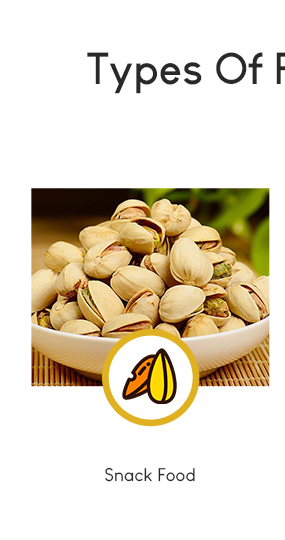 |
 |
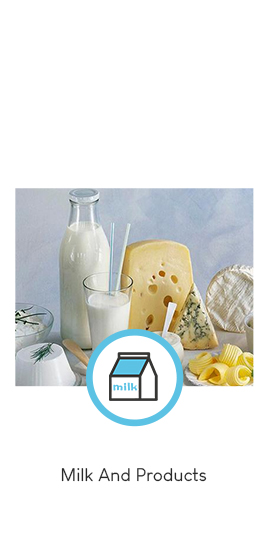 |
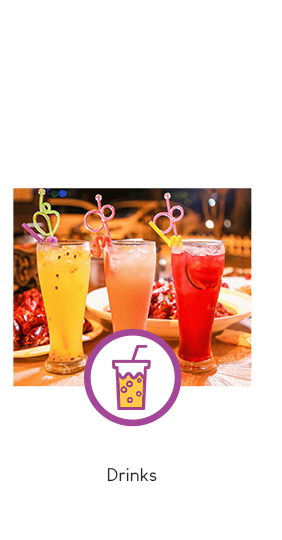 |
||
 |
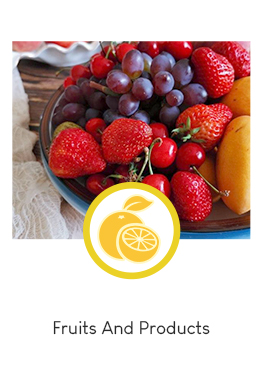 |
 |
 |
||
 |
 |
 |
 |
||
 |
 |
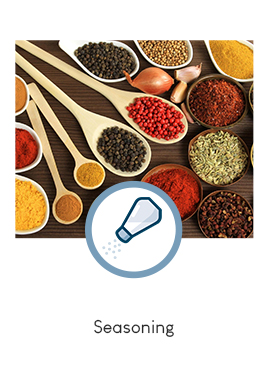 |
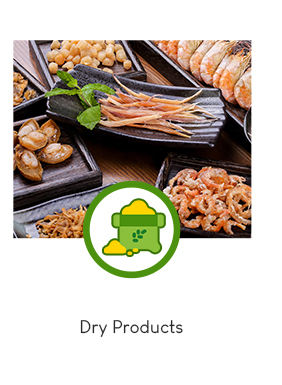 |
||
 |
|||||
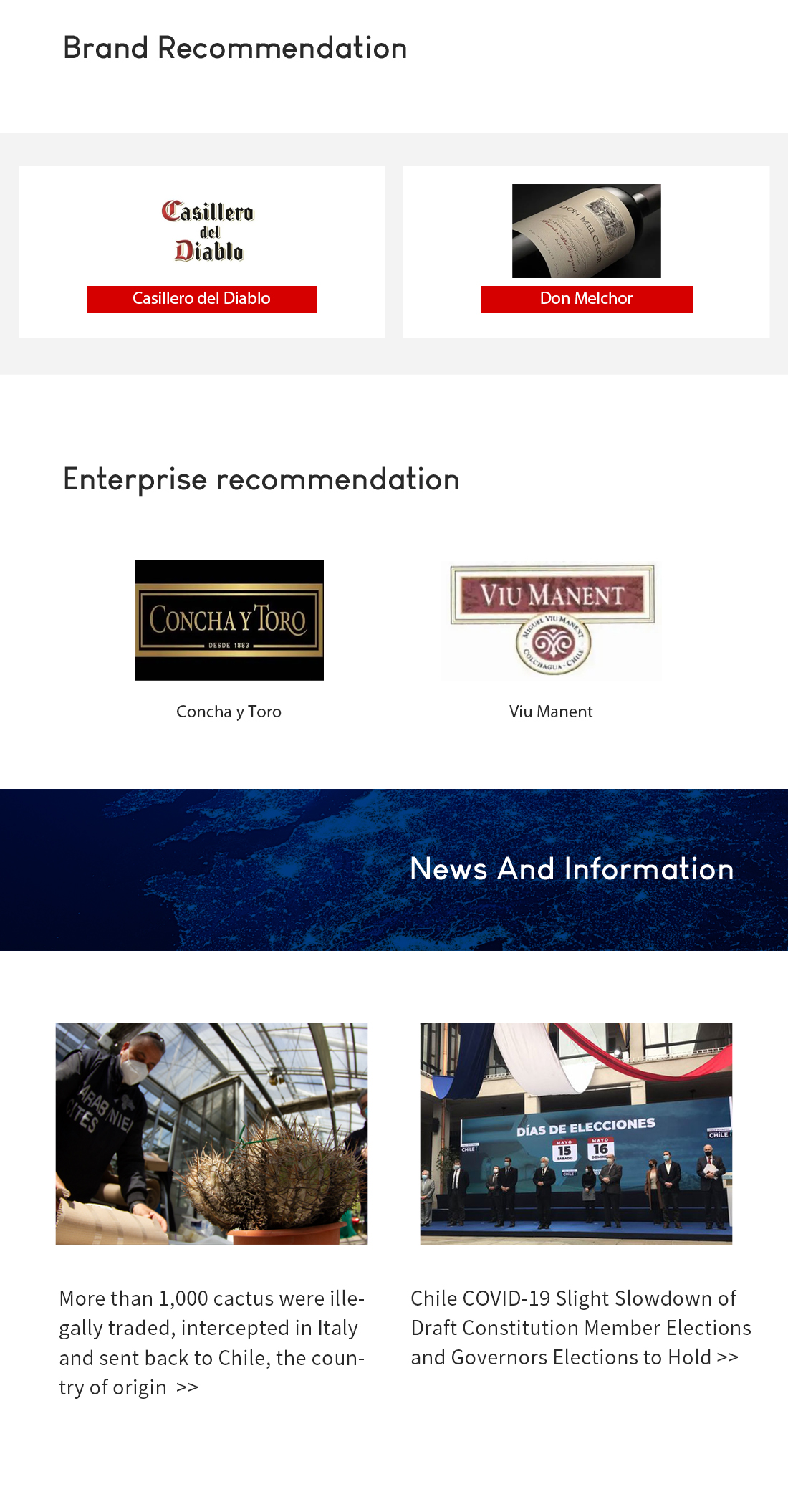
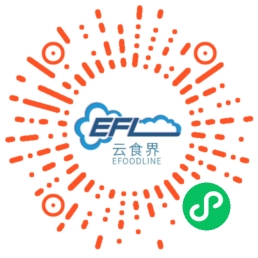 微信小程序
微信小程序



